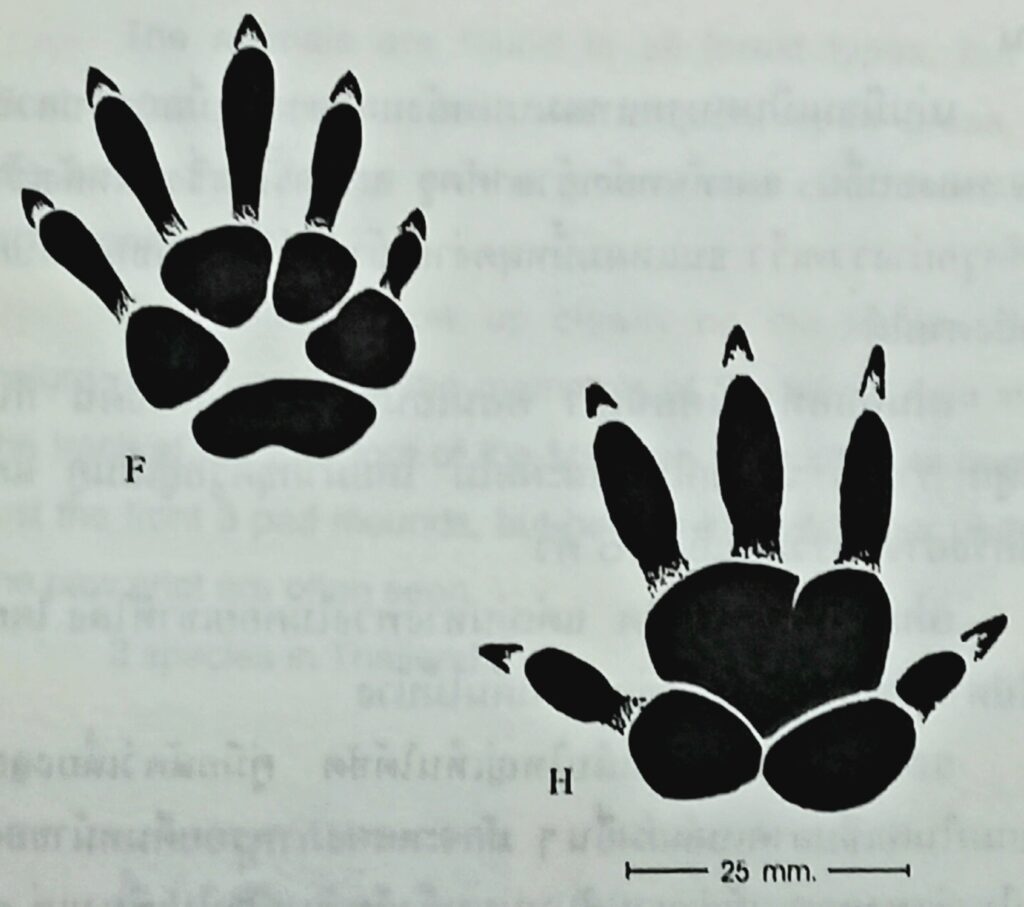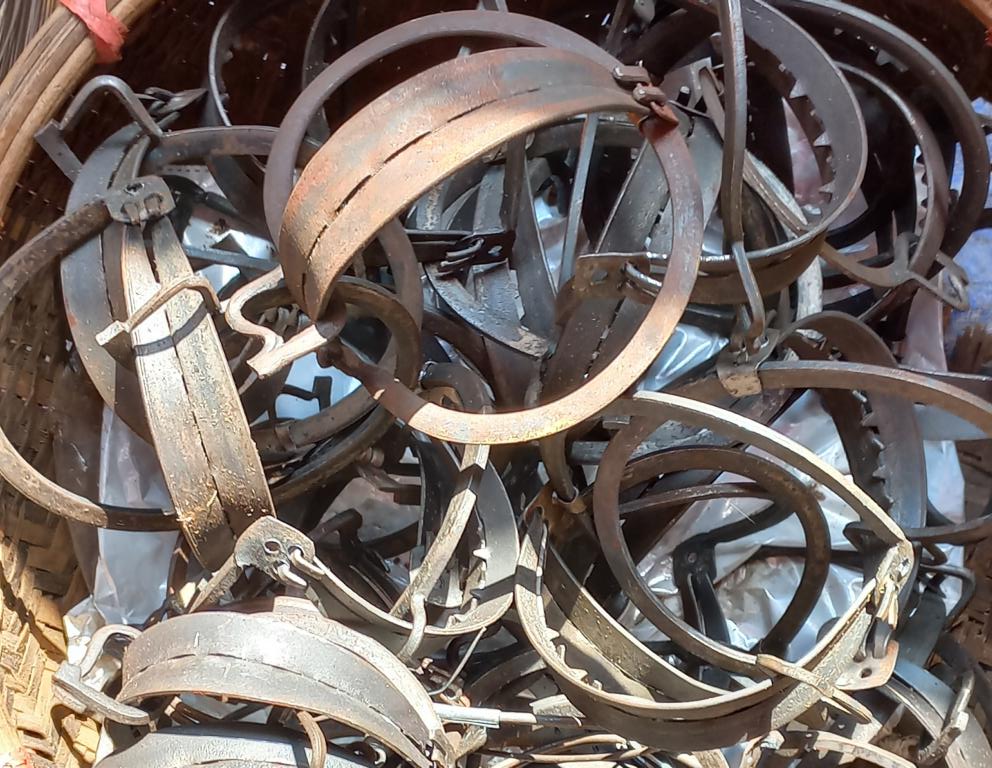Bamboo rats are a common rodent in bamboo thickets in mountainous areas of northern Vietnam. Hmong tribal people in remote regions still hunt them regularly for food. Although hunting bamboo rats is officially prohibited, the practice is still widespread. To document this practice, the following will describe how they are hunted for food. And we also bought a rat from a licensed Bamboo rat farmer for culinary purposes.
Animal description
In Vietnam, three species of bamboo rats are known:
- Large bamboo rat (Rhizomys sumatrensis),
- Lesser bamboo rat (Rhizomys praeceptor) and the
- Tonkin bamboo rat (Rhizomys laoensis).

The Hmong population in the area we visited hunted Large bamboo rats. This bamboo rat species can grow to 50 cm/ 20’’ in length and weigh up to 4 kg / 8.8 lb. Characteristically, its tail can be up to 20 cm / 7.9’’ long, it is naked, longer than other species in the family, and the tip is pink.
Large bamboo rats prefer secondary growth with large stands of bamboo in mountainous areas. They dig extensive burrows with their teeth and feet. The tunnel diameters are around 15 cm / 6’’, and the tunnel system can extend up to 5 m into the ground. At a populated tunnel entrance, there are always green leaves scattered around. Also, the tracks of R. sumatrensis are very conspicuous due to the shape and size of their claws. Both Front- and Hind tracks are of similar size.

Behavior of Bamboo rats
They usually stay underground during the day, coming out at night to roam widely through the bamboo thickets. It is known that they also climb bamboo culms by straddling the stem between their legs and, with their teeth, cutting out regular sections of the stem wall, which they then take down to their burrow. This is a good indication of R. sumatrensis being around. Their diet is mostly bamboo roots, though they also take shoots. When located near civilization, they may cause some damage to sugar cane, tapioca crops, and tea bushes.

Bamboo rats are shy animals, but when threatened, they assume a defensive posture with their heads raised and mouths open to show the huge incisors. With these, they are capable of putting up a stiff fight. As a further deterrence, they may also grind their molar teeth noisily or make harsh grunts.
Bamboo rats are the natural hosts for the mold Talaromyces marneffei, which is endemic to all bamboo rat species in Southeast Asia. In this area, talaro-mycosis due to this mold is the third most common opportunistic infection in HIV-positive individuals – about 10% of patients in Hong Kong contract talaro-mycosis as an AIDS-related illness.
Distribution

Healthy populations exist in northern Vietnam, Laos, Peninsular Malaysia, and the northern half of Sumatra. Additionally, they occur in regions of Myanmar, Thailand, Cambodia, and Southern China.
How to hunt Bamboo rats
Hmong tribals in northern Vietnam hunt these nocturnal rodents by trapping, flooding, or digging.
Trapping with steel jaw traps.

The hunters use a local version of a steel jaw trap to catch Bamboo rats. The trap’s jaws are around 6’’ or 15.2 cm long and studded with teeth. When sprung, the jaws catch the animal behind the head. Hardware traders freely sell these traps at weekly markets in the area.
Flooding of the burrow
I went with Hmongs, who preferred flooding the burrows with water to catch Bamboo rats. These burrows are typically complex and can include several entrances and multiple chambers, where the rats create nests and store food. The whole complex can be between 2 and 5 meters deep into the hillside, and a typical tunnel diameter is about 15 cm / 6’’.
After surveying the area for visible entrances and exits, the hunters pour water from buckets into the uppermost burrow opening. There are many small streams around these hills, so this work is tedious but still manageable. And it only works, as the soil is very loamy and water does not seep away through the soil around the tunnels and chambers. When the rats are flushed out of their lairs, the waiting tribals try to dispatch them with shovels.
Digging Bamboo rats out of their burrows


That is the most work-intensive method of catching them. After we found two freshly used entrance tunnels, we started digging on a steep hill.


We dug for about an hour and found one of the nests empty. Digging further, I slipped from the steep, wet, and very slippery loamy soil down the opened trench and thrust the end of the shovel handle into one of my eyes, considerably reducing our digging motivation.
Therefore, we contacted a local, licensed Bamboo rat farmer and bought one of his rats for the upcoming dinner. Bamboo rats can be lifted from the floor by holding them on the skin of the Back behind the head. But to hold them longer, lifting them on their tail is best. This way, they also can’t bite the handler.
Preparation of a bamboo rat for the table

After singing off the hairs and gutting, this cute rat soon landed on the cutting board. There, head to tail, it was chopped into pieces manageable for chopsticks. These pieces were fried together with lemongrass and onions.


Due to its incisors, the same Bamboo rat—alive and dead—could still be identified.

It was a delicious meal: Bamboo rat pieces dipped in salt with green chilies and rolled into an aromatic green leaf. The fried rat skin was chewy, but the meat was tasty.
In Vietnam, there are various recipes for Bamboo rats. In other places, they are often killed in a gruesome way by cutting their carotid artery and catching the blood.

Fresh blood is salted and whipped foamy to avoid coagulation. A dish called Tiết canh (blood pudding or blood soup) is made from this blood. While living in Vietnam earlier, I ate this blood soup made from duck blood and duck meat, but not from Bamboo rats.
As mentioned above, Bamboo rats are often boiled with lemongrass instead of fried. After that, the bodies are chopped and eaten with shrimp paste or cooked with turmeric and bamboo shoots and turned into Bamboo rat curry.
Lessons learned about Bamboo rats:
- Bamboo rats occur throughout northern Vietnam in bamboo forests at higher altitudes.
- These rats are often caught by steel jaw traps in front of their entrance tunnels.
- Another method of catching them is flooding the tunnel system with water.
- The most labor-intensive hunting method is digging them out of their tunnels.
.





